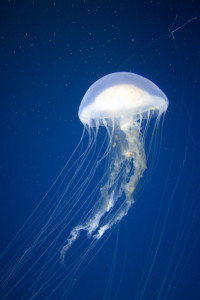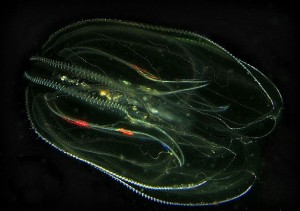Sea Nettles and Oysters Need Each Other To Survive

How Sea Nettles and Oysters Are Related
Sea nettles are a type of jellyfish, and they are creatures that everyone loves to hate. They gum up nets, sting you when you least expect it, and make water sports difficult. Jellyfish are one of those classic examples or creatures that humans tend to dislike, but they are an important species for ecosystem balance. This is because, despite their occasional annoyance, without sea nettles there might not be any oysters to eat or harvest.
Sea nettles (Chrysaora quinquecirrha) are one of many different types of gelatinous zooplankton (gooey floating animals) found in the waters of the Chesapeake Bay (and along the East coast). They're in the company of lion's manes, moon jellies, mushroom cap jellyfish, cannonball jellyfish, and the Portuguese man-of-war.

The story of sea nettles and oysters is really a triangle between the nettles, oysters, and another types of animal that is very much like a jellyfish, called a comb jelly or ctenophore (teen-a-fore). Sea nettles and ctenophores are made out of the same clear gelatinous stuff, but the ctenophores lack stinging tentacles, and don't have the typical umbrella shape of a true jellyfish. They also have rows of cillia (silly-a) inside their body beating that look like combs. The cillia move rapidly and make a current that draws water into their body to help them feed. When disturbed comb jellies also light up or glow.

Sea nettles aren't nearly as endearing because they don't glow and their tentacles can sting. Sea nettles can also be fairly large, about softball size, while comb jellies tend to be smallish, no larger than a tennis ball. People love to hate the stinging sea nettles and adore the the non-stinging ctenophores, but this love-hate relationship is actually backwards.
So what's the deal? Why should we really be appreciating the stinging sea nettles? It's because they eat ctenophores. True jellyfish, like sea nettles, are apex predators. This means that they are at the top of their food web. Without them the food web becomes unbalanced. You see, the sea walnuts or ctenophores feed on smaller plankton, including the larvae of young oysters, fish, and crabs. The larger sea nettle eats slightly larger fish and of course the ctenophores. They keep the ctenophore populations in check this way, which then protects baby oysters and other animal plankton that is critical to the human fisheries industry. But here's the rub.....
Ctenophores have a very short and sweet life cycle, going from eggs that are fertilized in the water, to larvae (they look like little adults), to adults within about a year. Sea nettles go through a two part life cycle. They start out as fertilized eggs in the water that develop into something that looks like a hairy jellybean, called a "planular larvae." These little guys float around until they find a good hard surface to land on, preferably oyster shells.

One they find a nice little hard reef of oyster shells (alive or dead), they sink onto the shells, attach, and become little polyps that grow to look like a sea anemone on a stalk. Now here's the neat part, the little anemone looking things make stacks of upside down baby jellyfish (without tentacles) that pop off into the water. At this stage they're called juvenile medusa or ephyra (ef-eye-ra). The juveniles float around, feeding on plankton as their tentacles grow, and eventually the become fully formed adult sea nettles.

It takes sea nettles about two years to go through their life cycle, and they require a hard surface for their polyp stage. Unfortunately, because oyster reefs have been removed from the Chesapeake Bay, and other places, it's hard for the sea nettle polyps to find suitable surfaces to land on and grow. This has created a shortage of sea nettles, and an overabundance of ctenophores because there aren't as many of their top predators to eat them! See the circle now? Oyster populations, and their larvae, depend on sea nettles to keep the population of hungry ctenophores in check. Sea nettles also depend on oyster shells to grow and bud in their polyp stage.
The food web, and structure of coastal ecosystems is super complex. This is just one example of how animals that humans love to hate are extremely important for ecological balance. Want to read more? Check out this paper about oysters and jellyfish by Denise Breitberg and Richard Fulford. Remember, even though nettles sting they are the good guys and should be appreciated for what they do for our fisheries and oceans.

